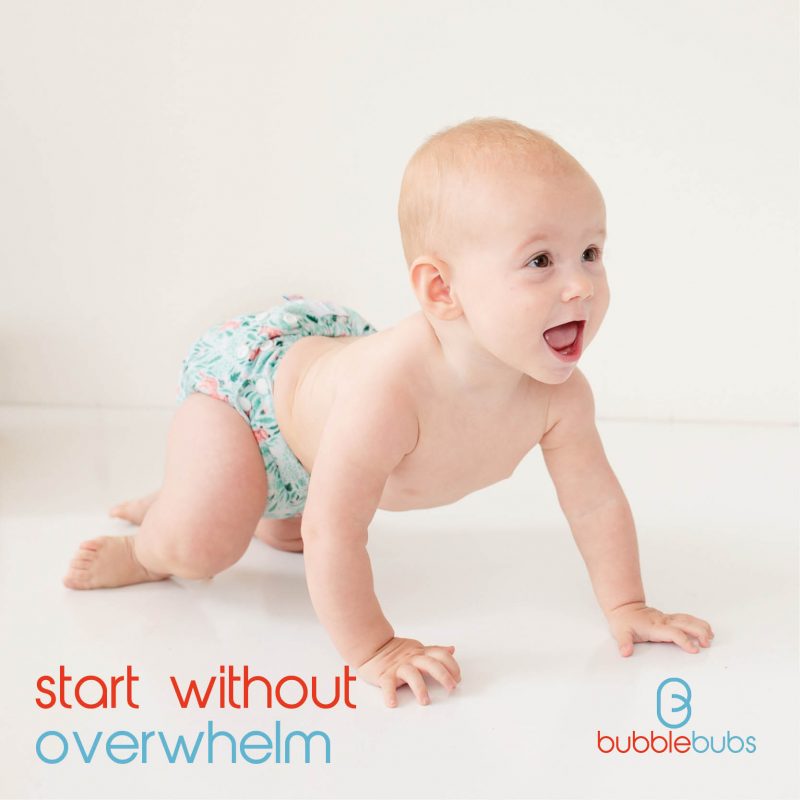
Cloth Nappies 101: Where to start without the overwhelm
Whether you’ve decided to take a definitive stand and join the cloth nappy club, or you’re just cloth-curious, you’ve come to the right place!
We want to make it as easy as possible for you to begin your cloth nappy journey. While it can seem overwhelming, there truly is an exciting element to using reusables. Knowing that every cloth nappy you pop on bub’s behind is one less disposable nappy in landfill makes you feel all warm and fuzzy inside. So let’s get you started! Here are some quick tips that will help you use cloth nappies with more confidence.
How many nappies do you need? To use cloth full time, you need 24 nappies. Thirty-six gives you a bit more wriggle room with drying and washing routines. The number of nappies you need also depends on how old your bub is and therefore how many nappies they’re using per day.
Day use is where many families initially build their confidence, then move to night nappies as baby gets older and needs less, or no, changes through the night. For the lowdown on night nappies, read Night nappies - the final frontier.
Newborn nappies: Newborn nappies are specifically made for fresh bundles so they will generally be one size and have less absorbency than a nappy for an infant or toddler. Having specific newborn nappies means they will fit better, be less bulky and reduce the wear and tear on your main stash. For the pros and cons newborn nappies, check out our previous blog post: Why should I buy newborn cloth nappies?
One Size Fits Most (OSFM) are adjustable nappies that will usually suit your bub from eight weeks (around four kilograms) to toilet training. At Bubblebubs, we have a few OSFM options including flats, Bamboo Delights and Candies. Candies are definitely the most popular and it’s no wonder why. They are easy to use, wash and assemble. They also come with a Nappy Guarantee. Our Nappy Guarantee means you can try one Candie for two weeks to see if it’s right for you - if it’s not, then you can return it for a full refund!
Styles: When it comes to cloth, there are so so many different styles.
Let’s start with the newer styles, which have come a long way since your grandma or your mum used cloth back in the day. To simplify, there are three main styles of modern cloth nappies (MCN): all-in-ones (Ai1), all-in-twos (Ai2) and fitted nappies.
Ai1s are nappies that have the insert sewn in. Some families starting out like this because the inserts can’t get mixed up between brands and they don’t need to be “assembled.” However, they may dry more slowly as they can’t be separated. Ai1s can also be more difficult to boost if you need different absorbency than what the nappy provides.
Ai2s are usually a shell or cover and an insert that snaps in. The drying time for shells is therefore lessened and you can wash and reuse them more quickly if you have extra inserts on hand. While you can sometimes reuse the shell of an Ai2, you would want to air it out between uses. If there’s any poop on the cover, or super wet elastics, it’s better to throw the cover in the wash than risk a rash.
Fitted nappies are shaped nappies that require a separate cover. Fitted nappies are easy to boost and offer two layers of protection. However, they are slightly more work to put on as they have a separate cover.
There are a range of more traditional cloth nappies like prefolds and flats that involve folding and a separate cover. These are really economical and customisable but do take a bit more work.
For a more detailed look at different styles, check out an overview of the Bubblebubs cloth nappy range.
Fabrics: Synthetic fibres like microfibre are great for wicking away moisture but they are prone to compression leaks (like a sponge) and don’t absorb as much. Natural fibres absorb more liquid so will last longer on your babe and won’t leak when they sit down.
Washing: there are some excellent guidelines offered by the Australian Nappy Association on how to wash your nappies. At Bubblebubs, our simplified wash guidelines aim to make it as manageable as possible to get that cute toosh back in your fave print. In a nutshell, you want to wash your nappies twice. The first wash, prewash, gets the bulk of the soiling out. The second wash, main wash, is the deep intensive wash that ensures all remaining soiling is removed and you’re not going to get any build-up of ammonia or bacteria. It depends on the size of your machine as to how many days apart you will do your main wash. However, dirty nappies shouldn’t really be left more than two days before a prewash as ammonia can eat away at your inserts. See our more detailed wash guide here.
Between washes, you want to keep your nappies in a dry airy basket to allow for airflow. Soaking isn’t a thing anymore. Not only is it a hazard for your babe to have buckets of water lying around, but extended soaking can ruin your shells, and water is an ideal breeding ground for that nasty bacteria.
What next?
The Australian Nappy Association also has a wealth of resources available. Look us up and see what people have to say.
Our blog also has a PLETHORA of information, from videos and podcasts, to articles about all things cloth nappies... you name it, we’ve got it! Have a bit of a deep-dive there and you’ll find everything you ever needed to know about cloth nappies. If you’ve got more questions, just reach out! We're here to help.
At the end of the day, the first step is always the hardest. You’ll never know if you never give it a go. So, you might as well just get started. Just dive in and remember we are here every step of the way!
By Katherine Edwards
